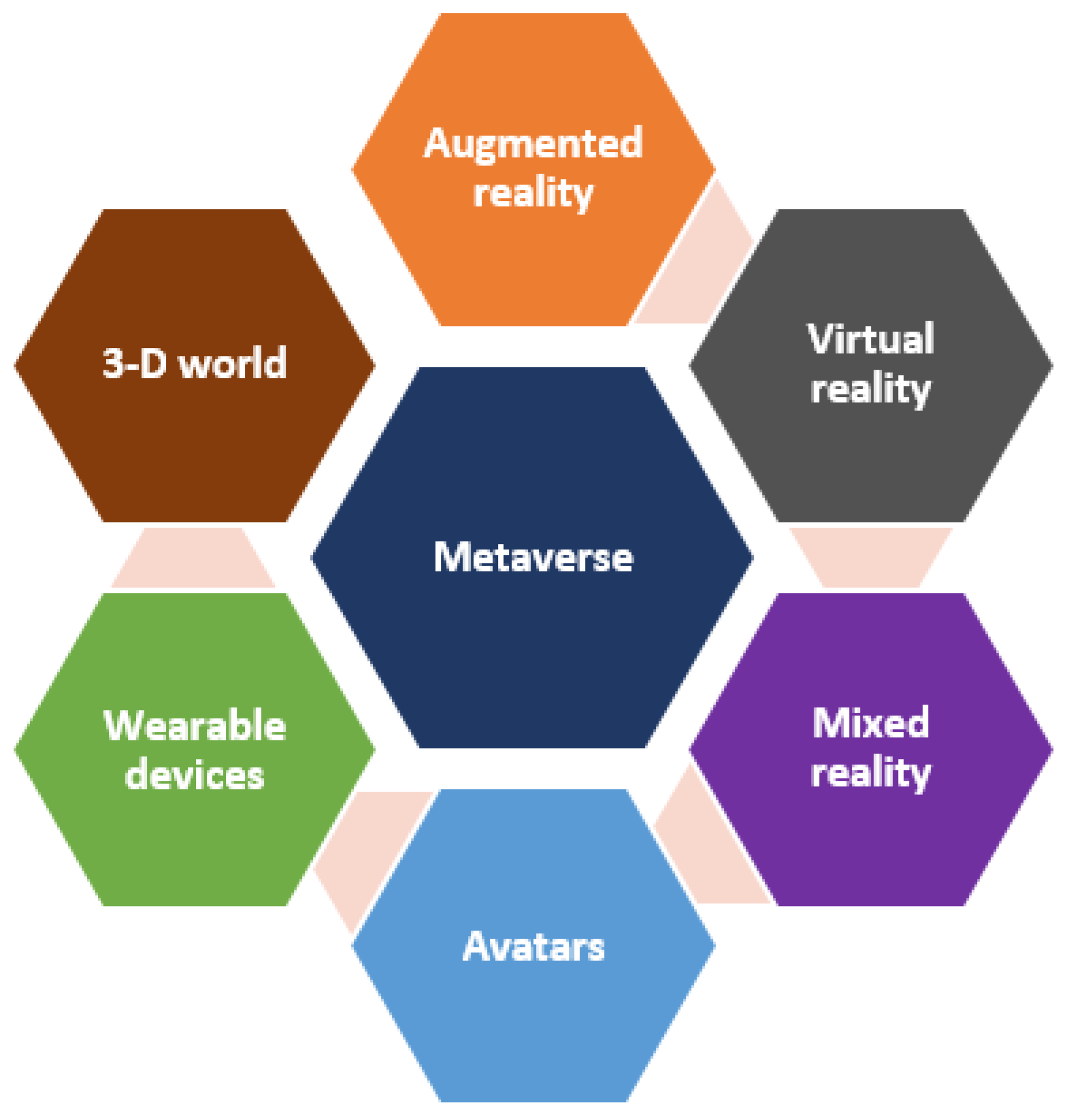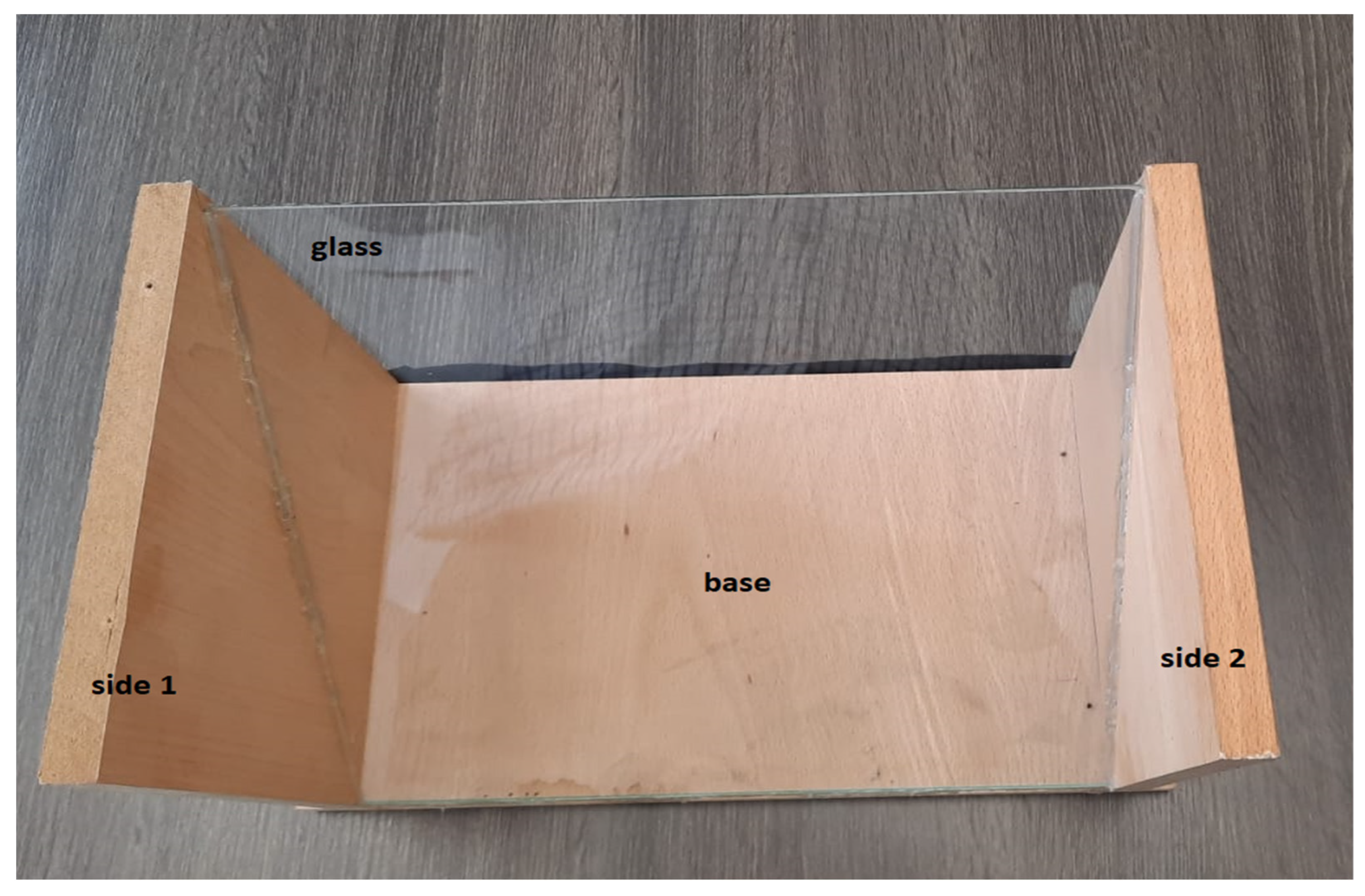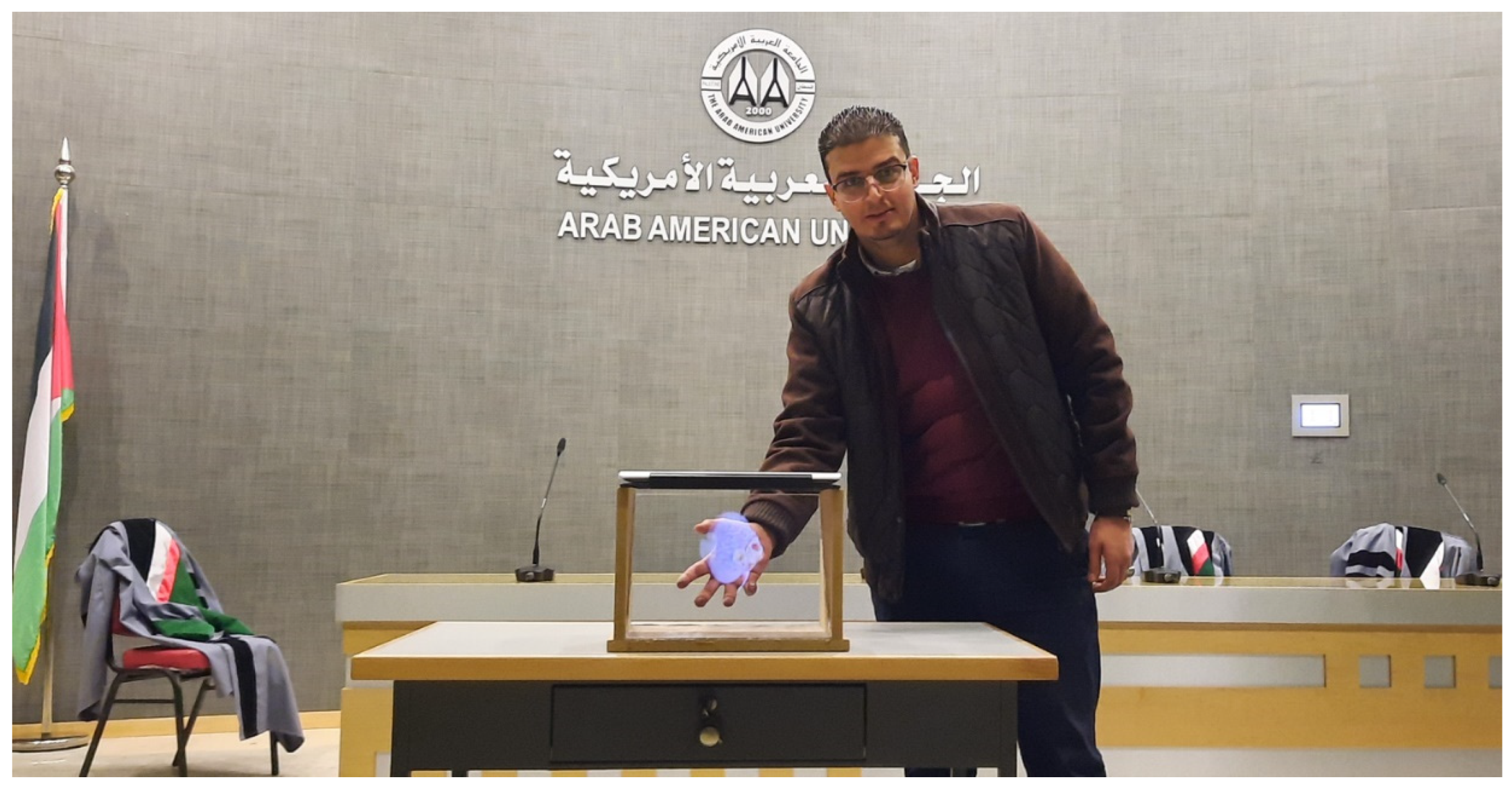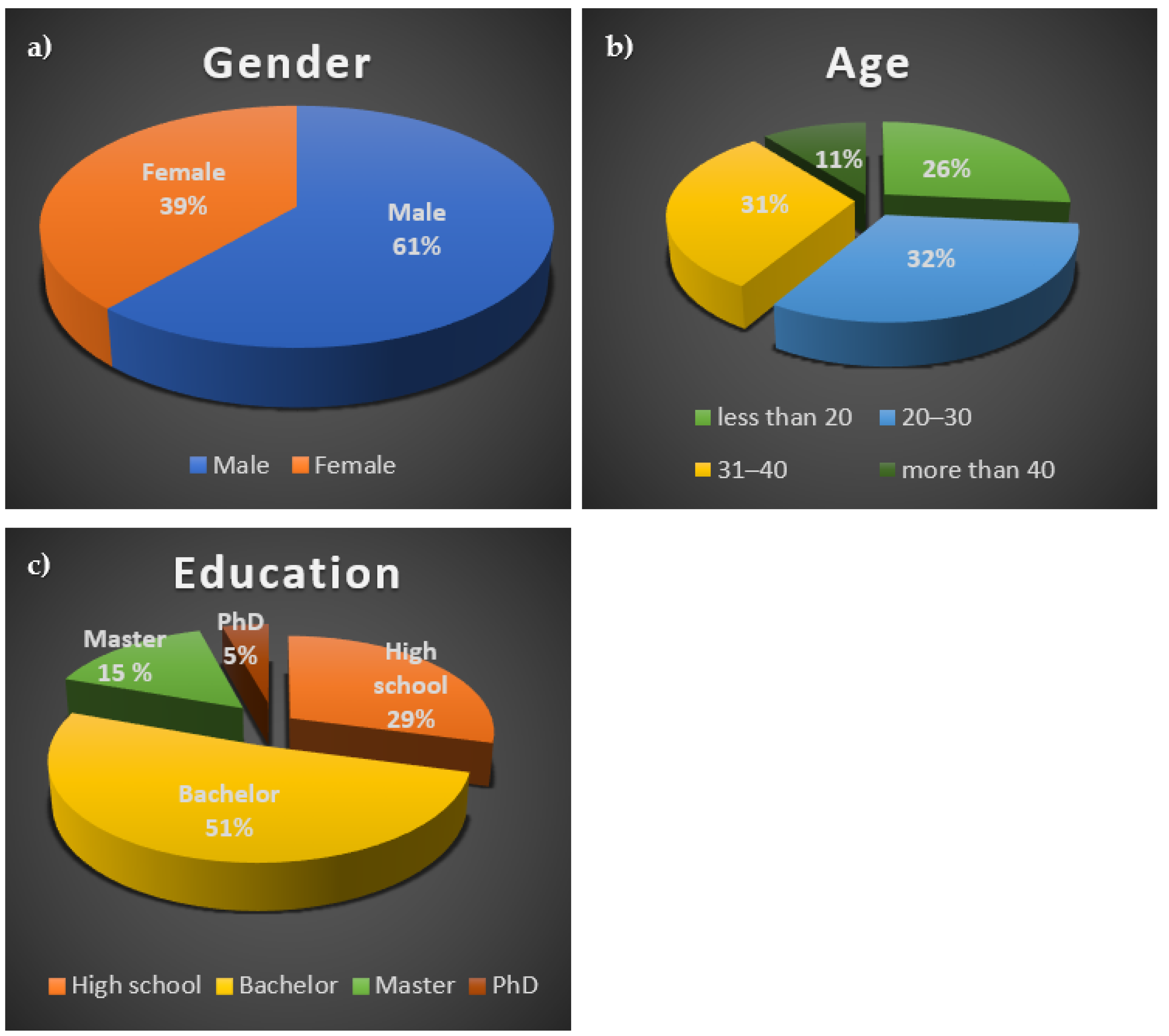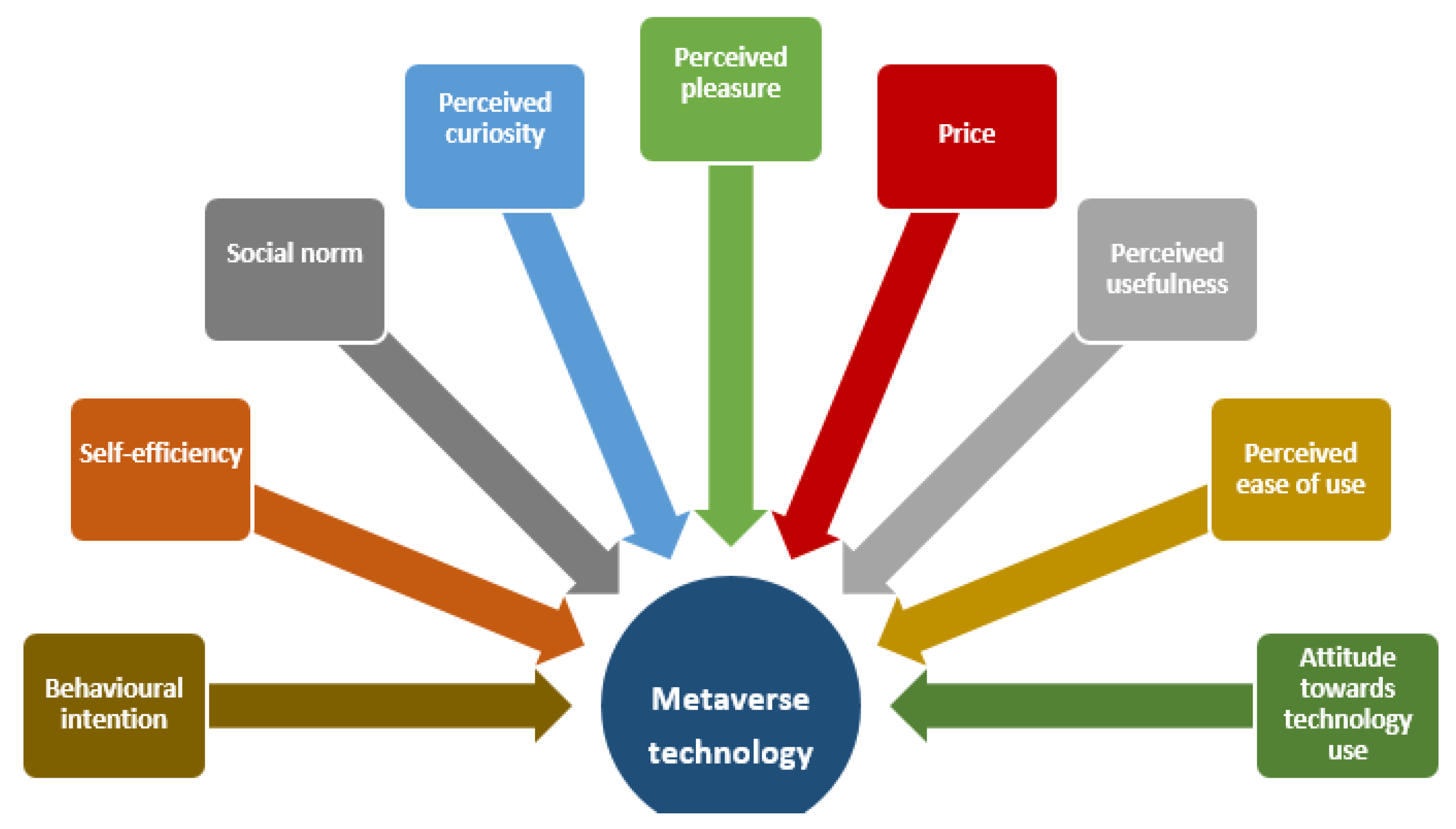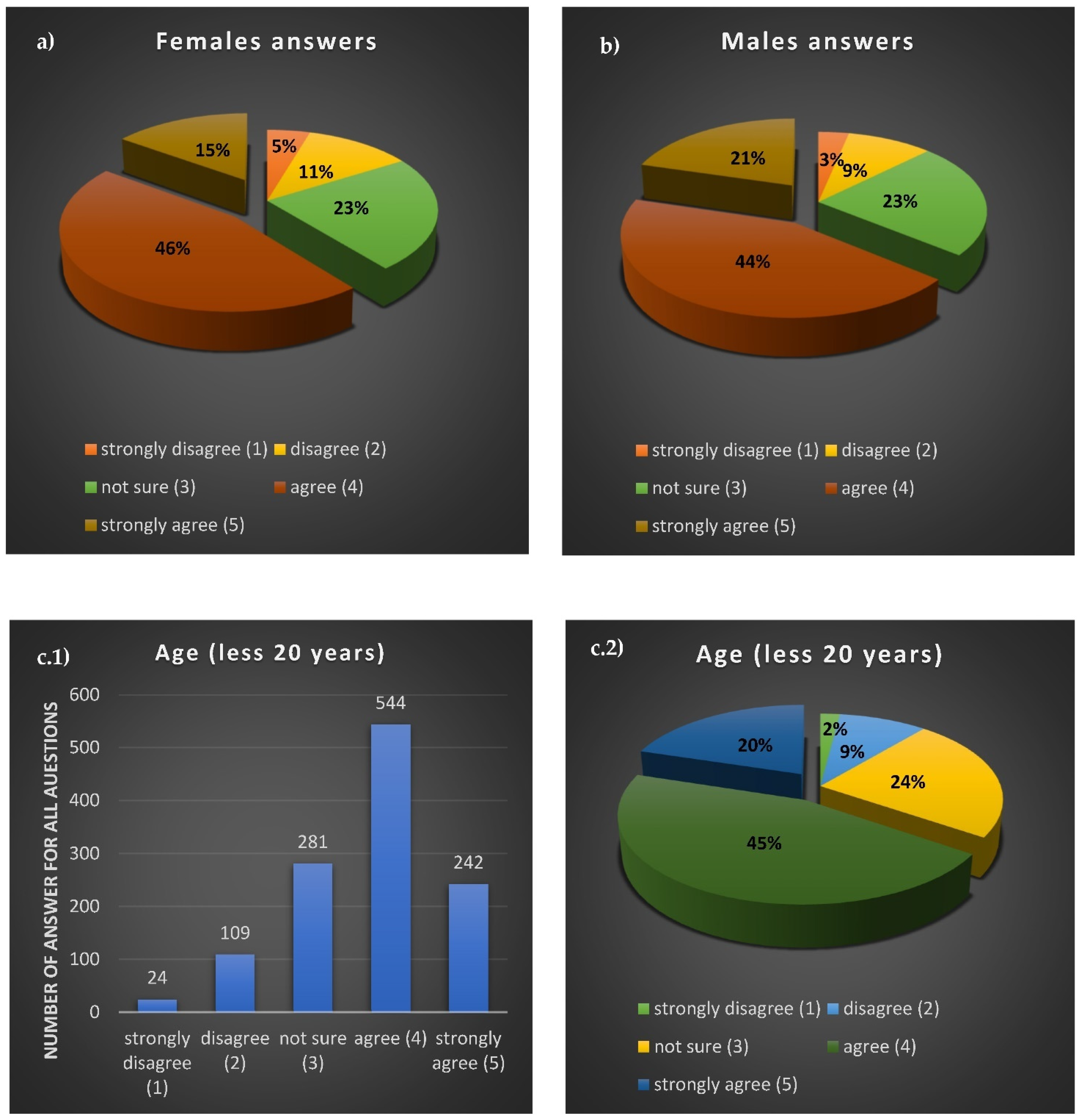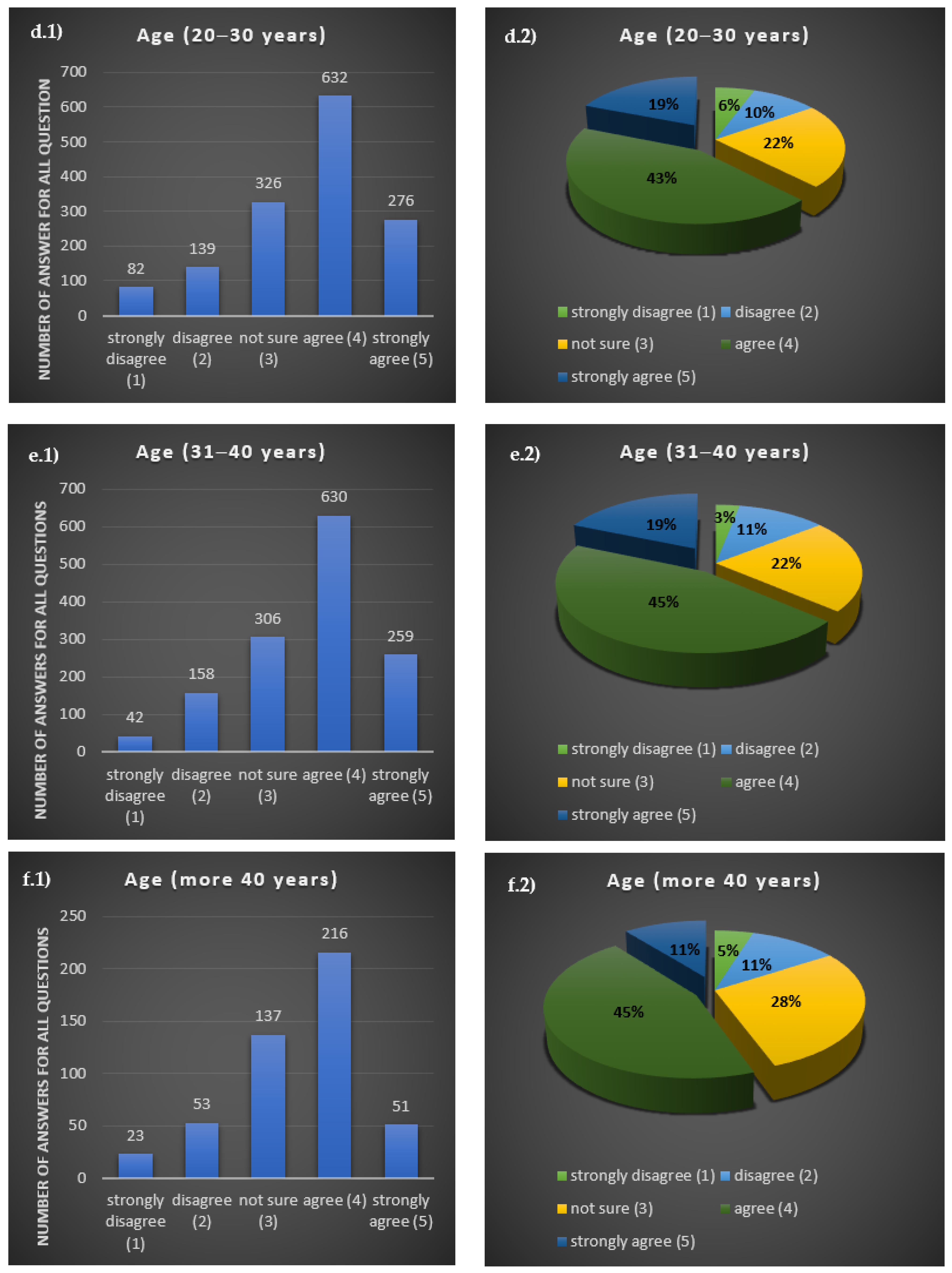1. Introduction
The deployment of technological innovations in various areas has an effective role in facilitating human life. It has become an essential need since we have entered the era of technological revolutions. Three major technical innovation waves have been recorded from the perspective of end consumers: the arrival of personal computers, the internet, and mobile devices [
1]. Virtual reality and augmented reality are examples of technologies that are driving the current fourth wave of computing innovations [
2]. The upcoming wave involves Metaverse technology, as illustrated in
Figure 1.
The Metaverse is a combination of the words meta (prefix meaning beyond) and universe; it combines multiple different virtual spaces (mix of virtual and augmented reality) to express real life using avatars [
3]. Although the metaverse does not yet exist in its entirety, metaverse-like features can be found on various platforms that use the virtual reality concept such as Pubg and Fortnite, second life games which allow users to make avatars which already can be used in Metaverse, hold in-game events, and build virtual economies. Through this technology, developers have pushed the boundaries of what a game can be [
4]. As new technology is raised, it is important to test its acceptance among users and investigate the variables that may affect the engagement of the new technology.
Researchers in the literature deploy different modeling in real-life applications. For example, the study in [
5] uses the multivariate adaptive regression splines model (MARS) and proposed two methods for the MARS knot positioning which are the hill-climbing method, and the hill-climbing method using prior change in RSS information. The study in [
6] offers an optimal wind turbine layout in a wind farm using support vector regression guided genetic algorithm, using such a model solve the wind warm layout optimization problem by combining the ability of each individual to adapt itself for better “fitness” with guiding information sampled from a response surface approximated by support vector regression.
Technology acceptance model was proposed by Davis [
7]. He states that perceived usefulness and perceived ease of use shape users’ attitudes towards technology use [
7], and that these attitudes influence users’ behavioral intention to actual usage or reject technology. It is a theoretical model that explains and offers a valuable framework for the attitudes toward new technology [
8]. Perceived usefulness and ease of use are the most critical variables that influence the use or rejection of new technology, which is also affected by other factors variables. A large number of studies used the technology acceptance model to investigate the attitude of new technologies. The authors of [
9] investigated students’ attitudes towards E-learning technology and found that the students’ perceived usefulness, efficiency, and effectiveness affect the acceptance of the technology. The study in [
10] investigates the antecedents to users’ decisions to revisit sites relevant to their jobs and found that the ease of understanding and finding affect perceived ease of use and usefulness affected by information quality. The study in [
11] investigates the intention to use healthcare information systems and found that service quality, system quality, and information efficiency positively affect the perceived ease of use and usefulness.
Since Metaverse is a mix of virtual reality, augmented reality, and real-life, in this section we will review some of these studies. The study in [
12] investigates the intention to use virtual reality and augmented reality technologies in classrooms. It found that technological pedagogical and content knowledge has a significant influence on perceived usefulness and perceived ease of use. In contrast, social norm influenced perceived usefulness, perceived ease of use, ultimately affecting attitudes toward technology use and then behavioral intention. The study in [
13] investigates the factors that affect users’ intention to use virtual reality in a dynamic learning environment and found that perceived health risk, enjoyment, behavioral control, performance expectancy, self-efficiency were directly or indirectly impact behavioral intention. Ref. [
14] investigates the factors that affect the attitude towards training and learning virtual reality technologies, and found that the interactivity of the virtual reality technology positively affects the desire to use it. The study in [
15] investigates the factors that influence the intention to use the virtual reality headset and purchase intention and found that variables such as effort expectancy, price effectiveness, and facilitation conditions are the influencing factors that directly determine the purchase intention. The study in [
16] used a technology acceptance model on anatomy learning using augmented reality and found that the factors of ease, usefulness, interest, and pleasure have positively affected the intention of use.
Since Mark Zuckerberg’s July announcement of Facebook’s intention to create a future Metaverse [
17], many researchers have envisioned the structure, business model, and challenges for the new technology. Some of these studies which are related to the Metaverse in the literature including [
18], which offers a virtual ecosystem, and research agenda for the metaverse; Ref. [
19], which discusses the nature of Metaverse, some of the problems and challenges, and the first application areas of Metaverse; and [
20], which analyses interest on the user side, the media side, and the research side to provide stakeholder insights into the successful adoption and growth of the Metaverse.
The study in [
21] tests the intention of using metaverse in Korea and found that self-efficacy, social influence, perceived pleasure, and interactivity positively influence perceived ease. Interactivity and social influence had a significant effect on perceived usefulness. A study in [
22] tested intention to use the Metaverse at Seol University using several factors and finds that perceived usefulness and perceived ease influence intention to use the Metaverse, perceived ease of use has an influence on perceived usefulness, content quality, perceived playfulness affect perceived usefulness, and social influence affects perceived usefulness and intention to use the Metaverse. Self-efficacy has influenced perceived ease and intention to use a Metaverse.
Due to accelerating technological development, it is essential to explain and review the behavioral acceptance of these technologies [
23]. The intent is to fill a gap in the literature by testing the intention of Palestinian users towards using Metaverse and determining the factors affecting it and the relation between these factors. This will offer a possible understanding of Palestinian users and their potential behavior that may affect the use of Metaverse. By understanding these factors, the producers of the Metaverse technology may know how to motivate them to use Metaverse and interact with this technology in a better way.
The remainder of the paper is structured as follows:
Section 2 describes the methodology used to investigate variables affecting the acceptance of Metaverse technology.
Section 3 describes the present study results,
Section 4 discusses the results and highlights motivations for future directions.
Section 5 draws the paper’s overall conclusions.
4. Discussions
Based on the survey questions visualization in
Figure 9, we notice that males (65% of answers were agreed and strongly agreed) were more interested in Metaverse technology than females. And the participants with age less than 20 were more interested in Metaverse technology than other age demography.
Perceived curiosity, perceived pleasure, and self-efficiency positively influence perceived ease of use, in other words, when Metaverse technology gives the user the pleasure and curiosity to explore it, that will help feel the ease of use of Metaverse technology.
Perceived pleasure, social norm, and perceived ease of use positively influenced perceived usefulness. In other words, the higher the technology gives the user the pleasure, the higher the user finds it useful, and when the technology is easy to use will improve its usefulness. Like other related studies, these findings suggest that social norm significantly influences perceived usefulness, which means that others’ opinions impact technology engagement.
Perceived usefulness and perceived ease of use positively influence attitude towards Metaverse technology use; this means when the Metaverse technology is useful and easy to use, the user will have a positive attitude towards it, which will positively influence behavioral intention.
Price negatively influences behavioral intention. This means that the Metaverse technology cost must be low and meet users’ expectations to have a positive intention to such new technology.
The relation between variables in the present study is in the same line with other related studies in the field [
7,
15,
21,
22,
28,
32].
In future work, we will consider the following: (1) increasing the sample size as this will give us a better indication of the acceptance of metaverse technology; (2) measuring other factors such as immersion, scalability, and diversity; (3) involve a diverse segment of educated and uneducated volunteers to fill out the questionnaire.
By measuring the previous factors in point 2 and examining the influence relationship between the factors with a large sample of diverse segment of educated and uneducated volunteers, research will bring a more detailed view of the Metaverse technology.
5. Conclusions
This study investigates the variables affecting the acceptance of the Metaverse technology by using extended technology acceptance model to measure different factors that may affect users’ behaviour and the relation between these variables and found that, first, the general indication among participants was positive toward the Metaverse use, and the males were more curious to try the Metaverse technology. Second, the study indicates that there is a significant negative relationship between price and behavioral intention, a significant positive relationship between other variables (social norm, self-efficiency, perceived pleasure, perceived curiosity, perceived usefulness, perceived ease of use, attitude towards Metaverse technology use, and behavioral intention). Finally, the relation between price and attitude towards Metaverse technology use was not significant; the relation between self-efficiency and perceived usefulness was insignificant (hypothesis 5, hypothesis 11 are rejected). In this research quantitative and qualitative research methods were used as well as hologram simulation was conducted to facilitate the understanding of research context. Then, a 5-point Likert-scale survey was deployed for data collection.
